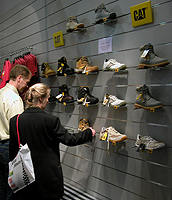 |
| Retail products, including scale models, are becoming profit centers for equipment manufacturers, dealers and collectors around the globe. |
Several construction equipment producers experiencing dips in demand have resorted to creative measures in order to boost revenue and spread brand equity. Logo merchandising, common to manufacturers promotional budgets for decades, is working its way more and more into the retail side of the business, and the numbers are staggering.
"Margins in the retail sector can be very good. If you get it right, it is far more profitable than manufacturing a wheel loader," says David Phillips, managing director of analyst firm Off-Highway Research in London. Phillips says that on average, equipment manufacturing only leaves producers with slim 2-3% profit margins, whereas retail merchandise broadens margins to 15-20%.
 |
| Caterpillar started licensing its logo for footwear in 1994 and continues to generate interest. |
Caterpillar, Peoria, Ill., was one of the first heavy equipment manufacturers to lead the charge in 1994, when it sold licenses to apparel producers who envisioned a mass retail market for CAT-branded work boots. In 1997, the company expanded into items like backpacks, key chains, jackets, baseball caps and tee-shirts. Today, the worldwide retail market for CAT apparel, accessories, scale models and toys is close to $800 million, according to Ric McDaniel, program manager for children's products and collectibles, at Intermat 2003 held May 13-17 in Paris.
What's more, Caterpillar charges prospective licensees a $1,000 fee just for consideration, says Daniel Hellige, manager of trademark merchandise licensing. He says the company reviews about 2,000 applications each year, and 99.9% are rejected. That's $2 million of annual revenue it can chalk up just for logo-licensing applications.
 |
| JCB recently expanded licensing programs for sporting goods and power tools. |
Sam Johnson, dealer merchandising manager for JCB in Rocester, U.K, says his company began its licensing program in 1996 with general apparel, having moved just recently into children's toys, sporting goods and power tools. He estimates the retail market for JCB "soft goods" at $65 million each year. "Retail is not a big business for us, but it is becoming a important profit center," says Johnson.
Newer competitors like Case Corp. Racine, Wis., and John Deere, Moline, Ill., have been equally successful with retail merchandise, especially within their global dealerships. "For the time being, merchandise is not a top priority, but the demand is there," says Michel Heusghem, a product support director based in Paris for Case, which started its program about four years ago. He estimates the annual market for Case-branded goods between $115,000 and $230,000.
 |
| Case is selling direct through dealerships but still brings in a few thousand dollars each year. |
Die-cast scale models alone, says McDaniel, fetch CAT retailers about $120 million annually. And at international trade shows like Intermat, it is not uncommon for attendees to find at least a dozen model collectors showing off their goods. Equipment enthusiasts and operators are excited to spend hard-earned dollars to own bookshelf-sized versions of the machines they use every day, says Martijn Knoops, operator for excavation contractor Swinkels in the Netherlands. Raphael Levy, an antique model collector in Strasbourg, France, adds that "some people want the real thing but just can't afford it.
(Photos by Tudor Hampton for ENR)
![]()

Post a comment to this article
Report Abusive Comment